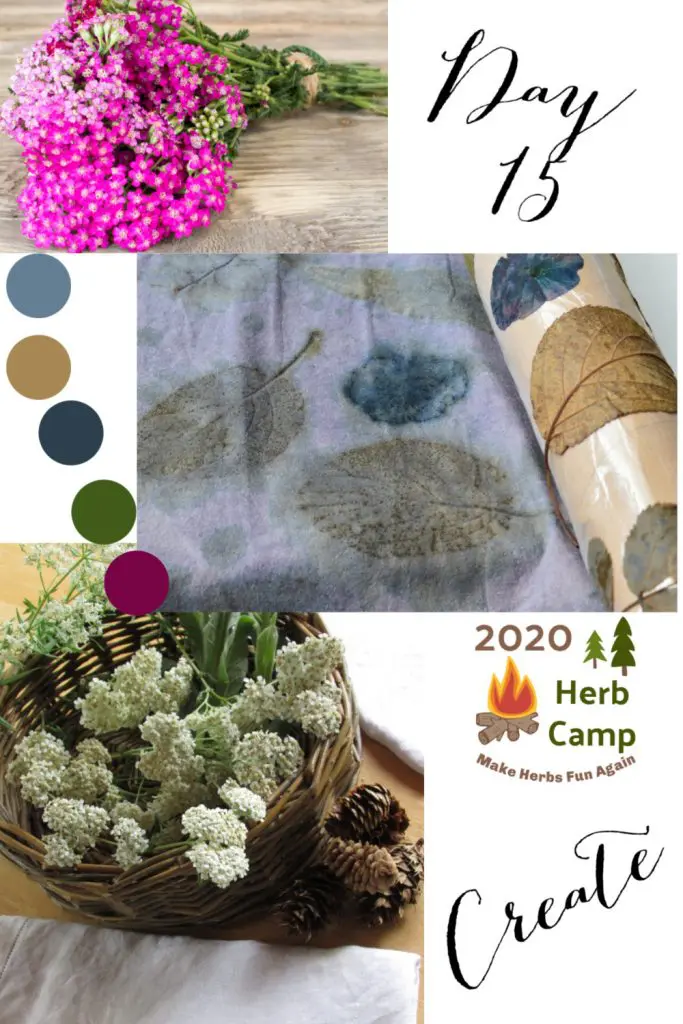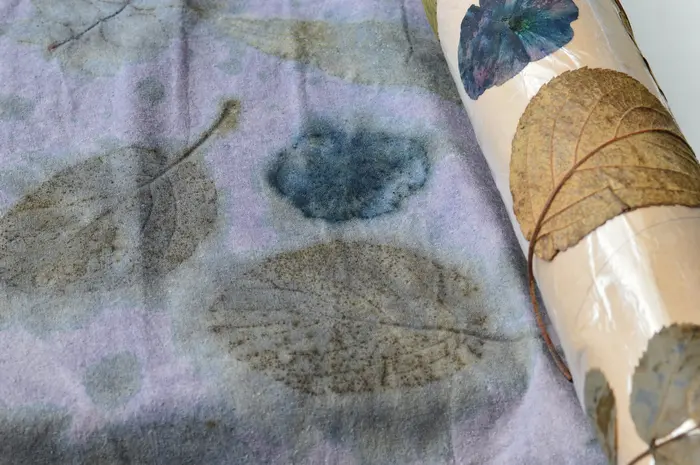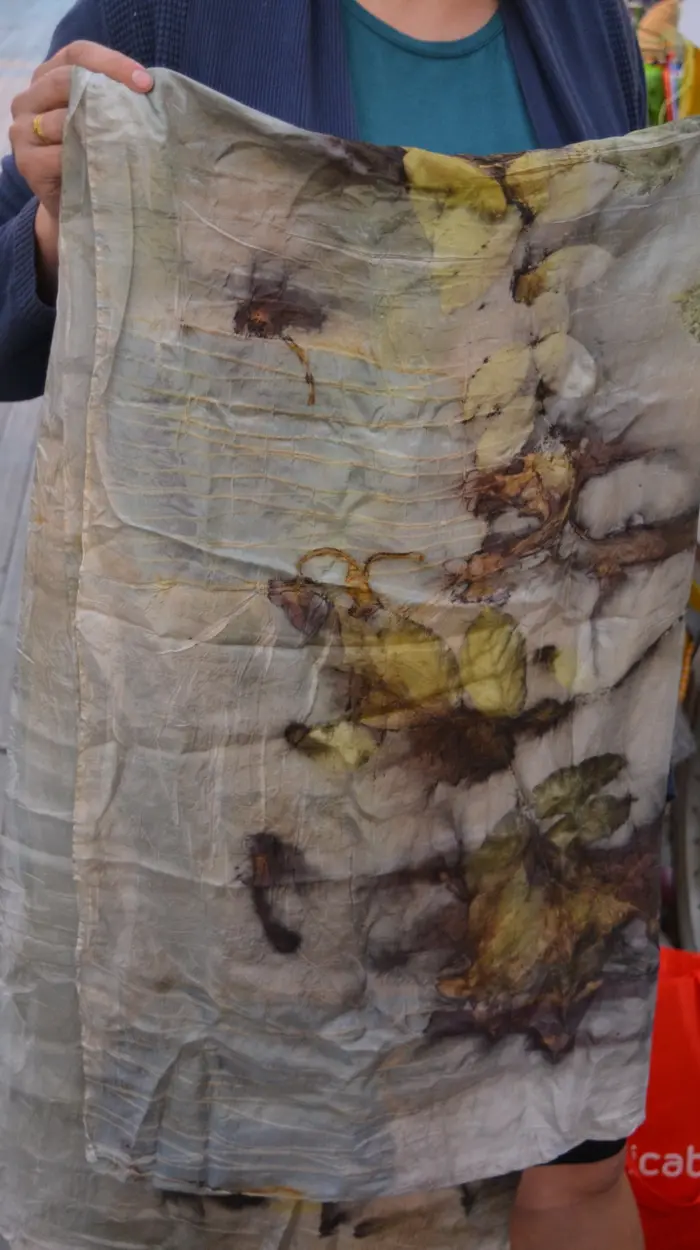WELCOME TO HERB CAMP 2020!
In this third of three weeks of herb camp, the theme is “Herbal Creativity” In this final week of herb camp we’ll explore ways to use your garden herbs creatively.
In today’s Herb Camp Challenge we’ll look at Eco Print natural dyeing.
Eco-printing is a form a natural dyeing that uses the leaves and flowers of plants directly on cloth, allowing the plant material to leave an imprint on the cloth. The flavonoids in the plants break down and transfer their color to the cloth.
You can read more about the process here:
How to Eco-print on Silk
This project will take longer than our usual 15 minutes a day. But once you have it set up and understand the process, you will be able to repeat the process over and over, in 15 minute increments. Step 1 and Step 2 can be done on several pieces of fabric all at once, and then the actually eco-printing can be done at your leisure. Many people use thrift store finds as their fabric. If you want to do that, look for garments that are 100% silk or 100% wool. 100% cotton garments can be used but the mordanting procedure is more complicated than the instructions I’m giving here.
How to prepare fabric for eco print dyeing
Eco print dyeing works best on silk or wool fabrics. Other natural fabrics can be used but the plant dyes seem to cling better to protein fibers.
Step 1 — Scour the Fabric
Wash the fiber with a mild detergent to remove any sizing or fabric coating. Some fabric is sold as RTD or Ready to Dye, and doesn’t require this step. But it should still be wetted before eco printing.
Step 2 — Mordant the Fabric
Mordanting is an essential step in dyeing with natural dyes, whether you are eco printing or dip dyeing your fabric. The mordant allows the color molecules to adhere to the fabric and remain. Mordanting makes the color fast and inhibits fading with light and washing.
Potassium aluminum sulphate (alum) is the easiest and safest mordant to use when dyeing with natural dyes on silk or wool fabric. It gives clear bold colors to protein fibers. Use 12 grams of alum to 100 grams of silk or wool fabric. Please wear a face mask rated for particulate matter (N95) when handling alum powder.
Dissolve the alum in hot water in a plastic bucket. Immerse the fabric. If the fabric floats on the surface of the bucket, weight it down to keep it submerged.
When using hot water, ensure that silk fabrics remain below 180 degrees F. to avoid damaging their luster. Leave it overnight in the bucket. Remove from the bucket and rinse in cold water. Its ready for the next step. If you plan to continue the project later, the mordanted material can be dried at room temperature and put aside for later use.
For cotton or linen garments or fabric you’ll need a different mordant, such as aluminum acetate, which can be purchased from a natural dye house. See this article for instructions on mordanting cotton.
Rayon (bamboo, tencel, etc) will also dye with natural dyes. Since it is a cellulose fiber use the same mordant that you would with cotton. Other man made fibers like polyester will not dye with natural dyes, so avoid blends of cotton and polyester garments or fabrics.
Step 3 — Under-dye the fabric with natural dyes
This step is optional but adds to the vibrancy of the colors in eco-print dyeing. If you are new to natural dyeing skip this step and move to Step 4.
If you wish to, you can under dye with a light under-color on the fabric before you begin the actual botanical print. To do this create a dye bath using natural dye plants such as:
For yellows:
- Golden Rod
- Dyer’s Weld
- Onion Skins
- Coreopsis
- Oregon Grape Root
- Turmeric Root
- Dyer’s Greenwood
- Apple leaves
- Rose leaves
- Marigold flowers
For reds and corals:
- Madder root
- Cochineal
- Bedstraw Roots
- Prickly Pear Cactus Fruit
- Red rose petals
- Deep red flowers
For Blues and purples:
- Woad Leaves
- Indigo Powder
- Japanese Indigo
- Log wood chips
- Sunflower centers or seeds
For Browns (Tannin + iron)
- Nut leaves
- Tea
- Coffee
Use the instructions for the natural dyes of your choice. For instance for yellows create a simmer dye bath and keep the temperature below 180 degrees F. for silk. Madder should be cold water dyed. Indigo requires a fermentation process to create a reduction dye vat.
Step 4 — Gather your plant materials
Go for a pleasant walk and take your gathering basket. Your personal place and the season that you gather in will determine your colors. This is the most fun. Go here to see Sarah’s ecoprint with woad on silk scarves.
The colors that will adhere to the fabric come from the same plant constituents as the plant’s antioxidants and medicinal qualities. The flavonoids, the anthocyanins, and the tannins in the plants along with the minerals carry the color to your cloth. These are the same constituents that hold the anti-inflammatory, pain relieving, anti-microbial, anti-fungal, and therapeutic actions that we value medicinal herbs for.
In ayurvedic tradition cloth is dyed with natural dyes in order to carry the therapeutic benefits of the plant to the person wearing the cloth. Since we’ve lost the cultural significance of natural color we’ve also missed our own understanding of the way plants offer their virtues through their color signatures, to our loss. Ecoprint dyeing is an easy way to bring this knowledge back, as the fabric is not only colored with natural dyes but the signature leaf, flower, or seed shape is imprinted on the cloth, as well. This leaves a permanent record of the plants used to dye the cloth.
Hint: Eco-printing can also be done on paper, leather, and other natural cellulose or protein fibers. This is a fun project to do with children.
More about this coming up in a future masterclass.
Your turn:
Take a photo of your project and upload it to the Facebook group here or (if you are not on Facebook) upload your photo to a photo sharing site and share the link here in the comments so we can admire your work.
Note: Click the small arrow on the LEFT to go to the previous day’s Herb Camp Challenge. Click the small arrow on the RIGHT to go to the next day’s Herb Camp Challenge.



I have been meaning to do sun printing but have not had time to do it. I have some PFD fabric. I am a quilter and some quilters design their own fabrics with sunprinting.
That’s very cool. I’ve seen sun printing but I’ve never done it.
By the way the scarf in the photo is lovely.
Did you underlay the background and then do the leaf prints?
Yes. It has a logwood underdye. Then the leaves were applied to the surface of the fabric
Will have to gather some supplies for this project as well..
Will have to try this with my granddaughter.